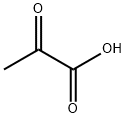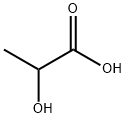Pyruvic acid
- CAS No.
- 127-17-3
- Chemical Name:
- Pyruvic acid
- Synonyms
- 2-OXOPROPANOIC ACID;Propanoic acid, 2-oxo-;pyruvic;CH3COCOOH;2-oxo-propanoicaci;NSC 179;FEMA 2970;PYRUVIC ACID;Pyruvia Acid;ACID PYRUVATE
- CBNumber:
- CB5257557
- Molecular Formula:
- C3H4O3
Lewis structure
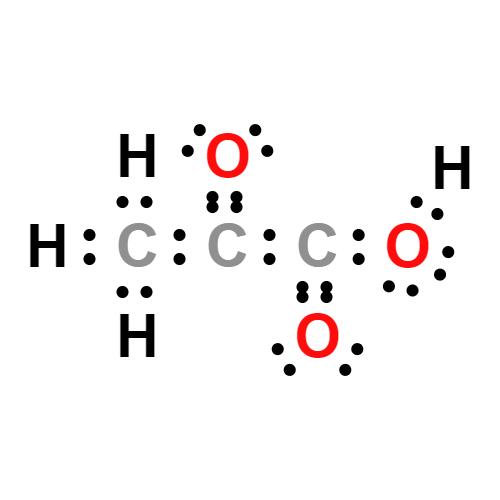
- Molecular Weight:
- 88.06
- MDL Number:
- MFCD00002585
- MOL File:
- 127-17-3.mol
- MSDS File:
- SDS
| Melting point | 11-12 °C (lit.) |
|---|---|
| Boiling point | 165 °C (lit.) |
| Density | 1.267 g/mL at 25 °C (lit.) |
| vapor pressure | 1.72hPa at 25℃ |
| refractive index |
n |
| FEMA | 2970 | PYRUVIC ACID |
| Flash point | 183 °F |
| storage temp. | 2-8°C |
| solubility | Miscible with chloroform and methanol. |
| pka | 2.39(at 25℃) |
| form | Liquid |
| color | Clear colorless to light yellow or amber |
| PH | 3.11(1 mM solution);2.38(10 mM solution);1.79(100 mM solution); |
| Odor | at 1.00 % in propylene glycol. sharp sour acetic caramellic |
| Odor Type | acidic |
| Merck | 14,8021 |
| JECFA Number | 936 |
| BRN | 506211 |
| Stability | Stable. Combustible. Incompatible with strong oxidizing agents, strong bases. Refrigerate. |
| InChIKey | LCTONWCANYUPML-UHFFFAOYSA-N |
| LogP | -1.24 |
| Dissociation constant | 2.49 at 25℃ |
| Substances Added to Food (formerly EAFUS) | PYRUVIC ACID |
| FDA 21 CFR | 172.515 |
| CAS DataBase Reference | 127-17-3(CAS DataBase Reference) |
| EWG's Food Scores | 1 |
| FDA UNII | 8558G7RUTR |
| NIST Chemistry Reference | Pyruvic acid(127-17-3) |
| EPA Substance Registry System | Propanoic acid, 2-oxo- (127-17-3) |
SAFETY
Risk and Safety Statements
| Symbol(GHS) |  GHS05 |
|||||||||
|---|---|---|---|---|---|---|---|---|---|---|
| Signal word | Danger | |||||||||
| Hazard statements | H314 | |||||||||
| Precautionary statements | P280-P301+P330+P331-P303+P361+P353-P305+P351+P338 | |||||||||
| Hazard Codes | C | |||||||||
| Risk Statements | 34 | |||||||||
| Safety Statements | 26-36/37/39-45-25-27 | |||||||||
| RIDADR | UN 3265 8/PG 2 | |||||||||
| WGK Germany | 3 | |||||||||
| RTECS | UZ0829800 | |||||||||
| Autoignition Temperature | 305 °C | |||||||||
| TSCA | Yes | |||||||||
| HazardClass | 8 | |||||||||
| PackingGroup | II | |||||||||
| HS Code | 29335995 | |||||||||
| NFPA 704 |
|
Pyruvic acid price More Price(47)
| Manufacturer | Product number | Product description | CAS number | Packaging | Price | Updated | Buy |
|---|---|---|---|---|---|---|---|
| Sigma-Aldrich | W297070 | Pyruvic Acid natural, ≥95%, FG | 127-17-3 | 25g | $99.4 | 2024-03-01 | Buy |
| Sigma-Aldrich | W297070 | Pyruvic Acid natural, ≥95%, FG | 127-17-3 | 100g | $227 | 2024-03-01 | Buy |
| Sigma-Aldrich | W297070 | Pyruvic Acid natural, ≥95%, FG | 127-17-3 | 1kg | $1510 | 2024-03-01 | Buy |
| Sigma-Aldrich | W297003 | Pyruvic Acid ≥97%, FG | 127-17-3 | 250g | $97.2 | 2024-03-01 | Buy |
| Sigma-Aldrich | W297003 | Pyruvic Acid ≥97%, FG | 127-17-3 | 1kg | $163 | 2024-03-01 | Buy |
Pyruvic acid Chemical Properties,Uses,Production
Uses
Intermediate in sugar metabolism and in enzymatic carbohydrate degradation (alcoholic fermentation) where it is converted to acetaldehyde and CO2 by carboxylase. In muscle, Pyruvic acid (derived from glycogen) is reduced to lactic acid during exertion, which is reoxidized and partially retransformed to glycogen during rest. The liver can convert Pyruvic acid to alanine by amination. A diagnostic agent for Parkinson disease.
Antioxidant effect
Studies have shown that pyruvic acid can inhibit the oxidation of oxygen free radicals in mice, and as a hydrogen peroxide scavenger, it has the effect of preventing free radical damage, and it has been proved to be protective in cardiac reperfusion injury and acute renal failure. The body resists functional damage. Pyruvic acid can act as an antioxidant through two mechanisms: first, as an α-keto acid, pyruvic acid can directly inhibit hydrogen peroxide through a non-enzymatic decarbonation reaction; second, supplementation of pyruvic acid can enhance In the citric acid cycle, after the production of citric acid increases, the phosphofructokinase is inhibited, thereby entering the pentose phosphate bypass to generate reduced coenzyme II (NADPH), thereby indirectly increasing the ability of the glutathione (GSH) antioxidant system. Pyruvic acid can also increase the ratio of coenzyme I/reduced coenzyme I (NAD+/NADH) and promote the reaction of the tricarboxylic acid cycle.
Chemical Properties
Colorless to light yellow liquid
Chemical Properties
Pyruvic acid has a sour, acetic odor (similar to acetic acid). It has a pleasant, sour taste with a burning, somewhat sweet note. It tends to darken and decompose unless kept free of minor contaminants and in tightly sealed containers
Occurrence
Isolated from cane sugar fermentation broth and from a few plants; also reported found in peppermint, raw asparagus, leaves and stalk of celery, onion, rutabaga, milk, cream, buttermilk, wheaten bread, blue cheeses, cheddar cheese, cottage cheese, provolone cheese, yogurt, beef, Virginia tobacco, beer, white wine, botrytised wine, cocoa and sake.
Uses
pyruvic acid is an alpha hydroxy acid that can be irritating and is considered difficult to work with. It has a larger molecular size than the most commonly used AHAs. Sodium pyruvate is more commonly used, and is an organic salt.
Uses
Pyruvic acid is used as a component in culture broths and media as commercial red seaweed polysaccharide. It is involved in the construction of amino acid alanine as well as supplies energy to living cells via citric acid cycle (Krebs cycle). It reacts with N-acetyl mannosamine by an aldol-type condensation to prepare sialic acid. It is employed to study the cultivation of soil bacteria as micro colonies using soil substrate membrane system. It finds application in liquid chromatography and in the determination of organic acids in red wine.
Preparation
By distillation of tartaric acid in the presence of potassium acid sulfate as a dehydrating agent; from acetyl chloride and potassium cyanide to yield the nitrile, which is subsequently acid hydrolyzed to the acid; pyruvic acid must be rectified under vacuum.
Definition
Pyruvic acid is an important organic chemical intermediate, an intermediate compound in the metabolism of carbohydrates, proteins, and fats, and is used in a variety of fields, including the pharmaceutical, cosmetic, food, and chemical industries. It has roles as a basic metabolite and cofactor. In thiamine deficiency, its oxidation is retarded and it tends to accumulate in neurostructural tissues causing neurological damage. In vitro studies have shown that pyruvic acid modulates cardiac function at physiological or low doses, but can cause cardiomyocyte damage at high doses.
Aroma threshold values
Aroma characteristics at 1.0%: acidic, sweet, caramellic and sour.
Taste threshold values
Taste characteristics at 5 ppm: sharp acidic, sour fruity, with sour creamy and caramellic nuances.
General Description
Pyruvic acid is the key component formed during the hydrolysis of flavor-precursors called S-alk(en)yl-L-cysteine-sulfoxides in onion tissues by allinase during maceration or chopping. The amount of pyruvic acid formed is used as a measure for onion pungency.
Biochem/physiol Actions
Taste at 5 ppm
Biotechnological Applications
Pyruvic acid is a key position in cell metabolism and is involved in many catabolic and anabolic pathways, including glycolysis, gluconeogenesis, amino acid, and protein metabolism. Pyruvic acid is employed for the production of L-tryptophan, L-tyrosine, and 3,4-dihydroxyphenyl alanine in various industries. The diet supplementation with pyruvic acid increased fat loss and minimized the associated loss of body protein. Pyruvic acid is also used in biochemical researches and medicine as a substrate for assaying activities of such enzymes as pyruvate dehydrogenase, pyruvate carboxylase, and pyruvate decarboxylase (Nakazawa et al. 1972; Yamada et al. 1972; Stanko et al. 1992).
Y. lipolytica oxidize glucose and form pyruvic acid (75–80 %) and a-ketoglutaric acid (20–25 %) under thiamine deficiency conditions. The synthesis of the acid was triggered by a decrease in intracellular thiamine concentration to 3.0 lg per 1 g biomass. An approximately 3-fold increase in the amount of the biomass was associated with a subsequent decrease in thiamine content to the level of 1.0 lg per 1 g biomass, whose maximum production of pyruvic acid was 50 g/L in this condition. In addition to glucose, thiamine-auxotrophic yeasts are capable of synthesizing pyruvic acid when grown on glycerol and propionic acid. Technicalgrade glycerol is the most promising raw material for pyruvic acid production. Pyruvic acid was obtained at a concentration of 61 g/L with a yield of 71 % from glycerol (Morgunov et al. 2004; Finogenova et al. 2005).
Synthesis
Pyruvic acid's synthesis method is as follows: from Tartaric acid by heating with hydrophilic agents, such as Potassium hydrosulfate.
Purification Methods
Distil it twice, then fractionally crystallise it by partial freezing. [Beilstein 3 IV 1505.]
Pyruvic acid Preparation Products And Raw materials
| Supplier | Tel | Country | ProdList | Advantage | |
|---|---|---|---|---|---|
| LEAPCHEM CO., LTD. | +86-852-30606658 | market18@leapchem.com | China | 43348 | 58 |
| Shanghai Jinli Pharmaceutical Co.,Ltd | +86-21-57256005 +86-15921811235 | chang@shjlchem.com | China | 20 | 58 |
| Hebei Mojin Biotechnology Co., Ltd | +86 13288715578 +8613288715578 | sales@hbmojin.com | China | 12460 | 58 |
| Hebei Guanlang Biotechnology Co,.LTD | +86-19930503253; +8619930503252 | daisy@crovellbio.com | China | 5840 | 58 |
| Hebei Dangtong Import and export Co LTD | +8615632927689 | admin@hbdangtong.com | China | 984 | 58 |
| Zibo Hangyu Biotechnology Development Co., Ltd | +86-0533-2185556 +8617865335152 | Mandy@hangyubiotech.com | China | 10978 | 58 |
| Hebei Jingbo New Material Technology Co., Ltd | +8619931165850 | hbjbtech@163.com | China | 1000 | 58 |
| Hebei Saisier Technology Co., LTD | +86-18400010335 +86-18034520335 | admin@hbsaisier.cn | China | 981 | 58 |
| Hebei Zhuanglai Chemical Trading Co.,Ltd | +8613343047651 | admin@zlchemi.com | China | 3002 | 58 |
| Hebei Longbang Technology Co., LTD | +86-18032476855 +86-18032476855 | admin@hblongbang.com | China | 953 | 58 |
Related articles
- The use of pyruvic acid in the treatment of skin disease
- Pyruvic acid has been recently used as a medium chemical peeling agent in subjects with skin diseases, such as acne melasma an....
- Nov 13,2023
- Different preparation methods of pyruvic acid
- Pyruvic acid, also known as a-oxopropionic acid, is an organic compound with a chemical formula of C3H4O3 and a structure of C....
- Apr 20,2022
View Lastest Price from Pyruvic acid manufacturers
| Image | Update time | Product | Price | Min. Order | Purity | Supply Ability | Manufacturer | |
|---|---|---|---|---|---|---|---|---|
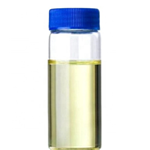 |
2024-07-25 | Pyruvic acid
127-17-3
|
US $0.30 / g | 1g | 99% | 300tons | Hebei Dangtong Import and export Co LTD | |
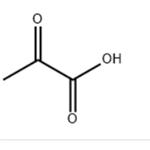 |
2024-07-25 | Pyruvic acid
127-17-3
|
US $23.00-10.00 / g | 1g | 99% | 8000g | Hebei Dangtong Import and export Co LTD | |
 |
2024-07-24 | 2-Oxopropanoic acid
127-17-3
|
US $1.00 / KG | 1KG | 98% | 50 ton | Hebei Guanlang Biotechnology Co,.LTD |
-

- Pyruvic acid
127-17-3
- US $0.30 / g
- 99%
- Hebei Dangtong Import and export Co LTD
-

- Pyruvic acid
127-17-3
- US $23.00-10.00 / g
- 99%
- Hebei Dangtong Import and export Co LTD
-

- 2-Oxopropanoic acid
127-17-3
- US $1.00 / KG
- 98%
- Hebei Guanlang Biotechnology Co,.LTD
127-17-3(Pyruvic acid)Related Search:
1of4





